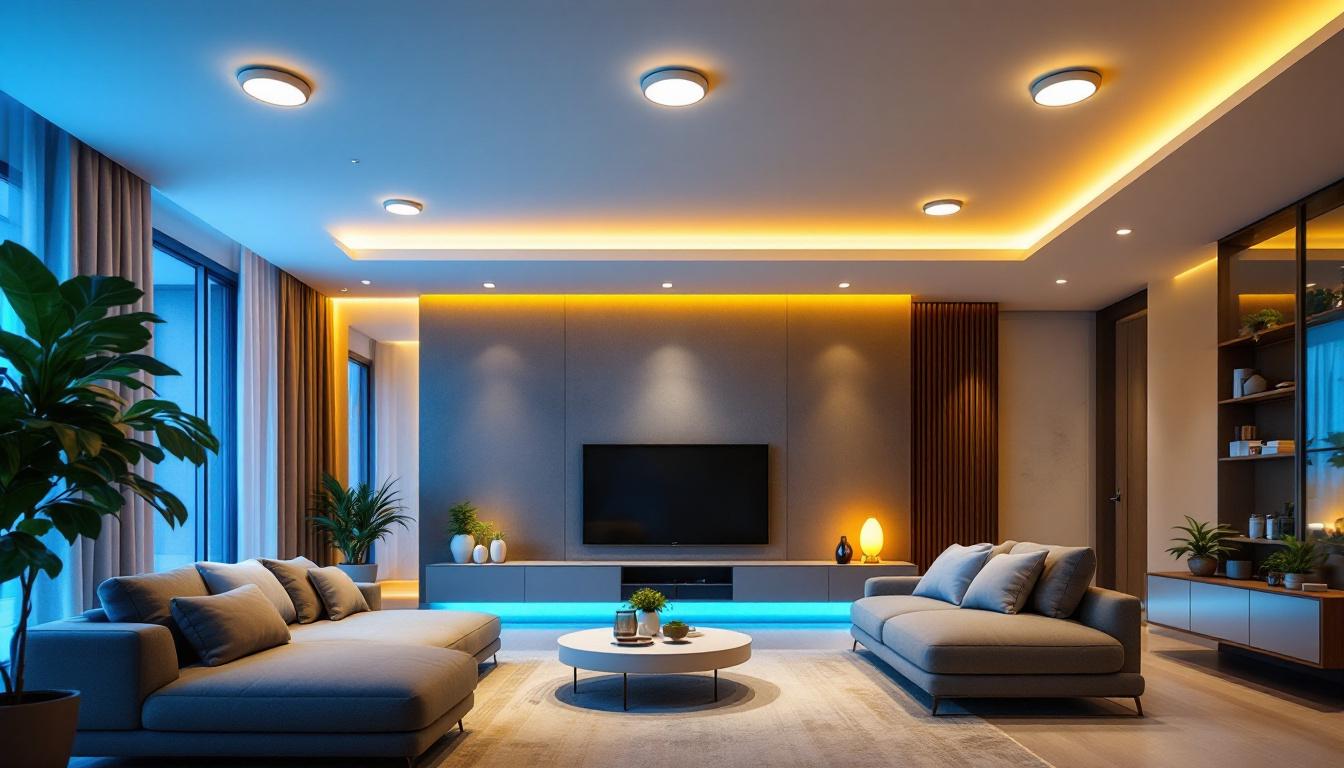
In the realm of contemporary lighting design, recessed lights have emerged as a staple for both residential and commercial spaces. Their sleek, unobtrusive appearance allows for versatile applications, making them a preferred choice among lighting contractors and designers alike. This article delves into the significance of recessed lighting, exploring its benefits, installation considerations, and the latest trends that shape modern lighting solutions.
Recessed lighting, often referred to as can lights or pot lights, is designed to be installed into a hollow opening in the ceiling. This type of lighting provides a clean and minimalist aesthetic, making it suitable for various environments. Unlike traditional light fixtures, recessed lights do not protrude into the room, allowing for a seamless integration into the overall design. This unobtrusive nature not only enhances the visual appeal of a space but also maximizes headroom, making it an excellent choice for rooms with lower ceilings.
In addition to their aesthetic benefits, recessed lights are highly versatile and can be used in a variety of applications, from general ambient lighting to task lighting in kitchens and workspaces. Their ability to be strategically placed can help eliminate shadows and create a well-lit environment, which is particularly beneficial in areas where detailed work is performed. Furthermore, with the advent of smart lighting technology, recessed lights can now be controlled remotely, allowing homeowners to adjust brightness and color temperature to suit their mood or activity.
There are several types of recessed lights available, each serving distinct purposes. The most common types include:
Understanding the components of recessed lighting is essential for effective installation and design. The primary components include:
Recessed lighting offers numerous advantages that make it an attractive option for various applications. Its benefits extend beyond aesthetics, influencing functionality and energy efficiency.
One of the most significant advantages of recessed lighting is its space-saving design. By being installed flush with the ceiling, these lights free up visual space, making rooms appear larger and more open. This is particularly beneficial in smaller areas where traditional fixtures might feel overwhelming. Moreover, the unobtrusive nature of recessed lighting allows for a clean and modern look, which can complement various interior design styles, from minimalist to contemporary. By eliminating bulky fixtures, homeowners can create a seamless ceiling line that enhances the overall architectural appeal of the space.
Recessed lights are incredibly versatile and can be used in a variety of settings. Whether illuminating a kitchen, highlighting artwork in a gallery, or providing ambient lighting in a living room, they can adapt to different lighting needs. Their ability to be dimmed or adjusted further enhances their functionality, allowing for tailored lighting solutions. Additionally, recessed lighting can be strategically placed to create focal points, guide the eye through a space, or even delineate different areas within an open floor plan. This adaptability makes them an excellent choice for both residential and commercial spaces, where the lighting requirements may change throughout the day or for different events.
With the rise of LED technology, recessed lights have become more energy-efficient than ever. LED recessed lights consume significantly less energy compared to traditional incandescent bulbs, resulting in lower utility bills and a reduced carbon footprint. Additionally, many LED options have a longer lifespan, minimizing the need for frequent replacements. This not only saves money over time but also reduces waste, making it an environmentally friendly choice. Furthermore, advancements in smart lighting technology allow homeowners to integrate recessed lights with home automation systems, enabling features such as remote control and scheduling, which can optimize energy use even further. This combination of efficiency and convenience makes recessed lighting a smart investment for the future.
While the benefits of recessed lighting are clear, proper installation is crucial to achieving optimal results. Lighting contractors must consider several factors to ensure a successful installation.
The type of ceiling and its height play a vital role in determining the appropriate recessed lighting solution. For instance, in rooms with high ceilings, deeper recessed fixtures may be necessary to ensure adequate light distribution. Conversely, in lower ceilings, shallow fixtures can provide sufficient illumination without overwhelming the space.
Proper spacing and placement of recessed lights are essential to avoid dark spots and ensure even lighting. A general rule of thumb is to space the fixtures approximately 4 to 6 feet apart, depending on the wattage of the bulbs used. Additionally, placing lights closer to walls can help create a more inviting atmosphere by eliminating shadows.
Electrical considerations are paramount when installing recessed lights. Ensuring that the wiring is up to code and capable of handling the load of the fixtures is essential for safety and functionality. It is advisable to consult with a licensed electrician to ensure that all electrical work is performed correctly and complies with local regulations.
The world of recessed lighting is constantly evolving, with new trends emerging that reflect changes in design preferences and technology. Staying informed about these trends can help lighting contractors provide cutting-edge solutions to their clients.
As smart home technology continues to gain popularity, the integration of smart recessed lighting systems has become a significant trend. These systems allow users to control their lighting through mobile apps or voice commands, providing convenience and flexibility. Features such as programmable schedules, color temperature adjustments, and dimming options enhance the user experience and energy efficiency.
Another trend is the use of adjustable color temperatures to create mood lighting. Recessed lights that offer tunable white options allow users to switch between warm and cool light, depending on the time of day or activity. This flexibility not only enhances the ambiance but also contributes to the overall well-being of occupants.
Recessed lights are increasingly being used to highlight architectural features and create dramatic accent lighting. By strategically placing recessed fixtures to illuminate beams, niches, or artwork, designers can enhance the visual interest of a space. This trend emphasizes the importance of thoughtful lighting design in creating a cohesive and inviting atmosphere.
Selecting the appropriate recessed lights for a project involves considering several factors, including the desired aesthetic, functionality, and energy efficiency. Here are some key points to keep in mind when making a choice.
The brightness of recessed lights is measured in lumens, and it is essential to choose fixtures that provide adequate light output for the intended space. For general lighting, a range of 1000 to 2000 lumens is typically recommended for larger areas, while smaller spaces may require less. Understanding the specific needs of each room will guide the selection process.
The trim style and finish can significantly impact the overall look of recessed lighting. Options range from sleek and modern to more traditional designs. Choosing a trim that complements the existing decor is crucial for achieving a harmonious aesthetic. Additionally, finishes such as matte, polished, or brushed can enhance the visual appeal of the fixtures.
When selecting recessed lights, it is vital to consider energy efficiency ratings. Look for fixtures that are ENERGY STAR certified, as they meet strict efficiency guidelines set by the Environmental Protection Agency. This not only ensures lower energy consumption but also contributes to sustainability efforts.
Recessed lighting plays a pivotal role in modern lighting solutions, offering a blend of functionality, aesthetics, and energy efficiency. As lighting contractors continue to embrace innovative technologies and design trends, the demand for recessed lights is likely to grow. By understanding the various types, benefits, installation considerations, and trends, contractors can provide clients with tailored lighting solutions that enhance their spaces.
Ultimately, the best recessed lights are those that meet the specific needs of each project while contributing to a cohesive and inviting atmosphere. As the industry evolves, staying informed and adaptable will be key to success in delivering exceptional lighting solutions.
Ready to elevate your lighting solutions with the best recessed lights on the market? Look no further than LumenWholesale, where we provide lighting contractors with superior, spec-grade lighting products at exceptional wholesale prices. Our commitment to quality and affordability ensures that you can light up any space with confidence. Say goodbye to inflated markups and hello to a vast selection of industry-standard lighting that won’t let you down. Plus, with free shipping on bulk orders, you can stock up on premium lighting effortlessly and economically. Don’t compromise on quality or value; choose LumenWholesale for Wholesale Lighting at the Best Value and make your next project shine.

Discover essential tips and common pitfalls for lighting contractors in this comprehensive guide.

Discover the essentials of Griplock systems tailored for lighting contractors.

Discover effective strategies for training your team in can light replacement, ensuring efficient and safe lighting upgrades.

Explore the advantages and drawbacks of fluo lighting for contractors.